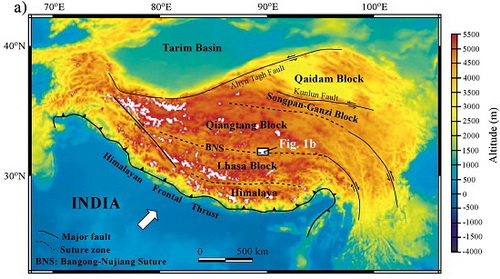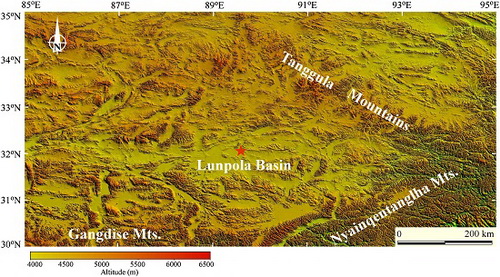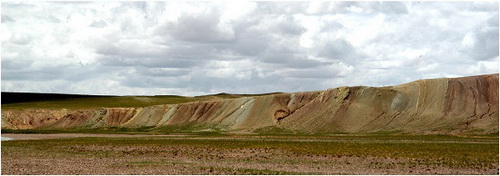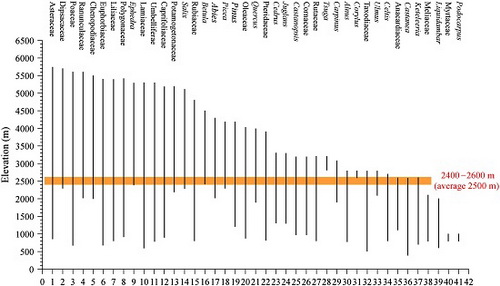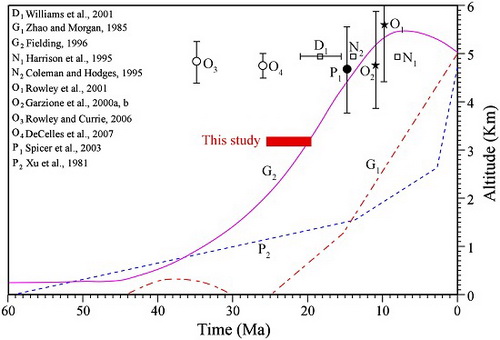Palynological evidence for the latest Oligocene-early Miocene paleo-altitude estimate in the Lunpola Basin, central TibetUpdate time:04 15, 2014
The uplift of the Tibetan Plateau is the result of the collision of India and Eurasia and has been ongoing since at least the early Cenozoic. At present, many important questions about the tectonics of the Tibetan region are still debated: What mechanisms can account for the uplift of the largest plateau? Did the different blocks that constitute the Tibetan Plateau have initial elevations before collision? What controls the diachronous uplift of the different parts of the plateau? When did the plateau reach its present elevation? Although many different methods have been employed to explore the above questions, one important approach is to study the paleoelevation of different blocks of Tibet before and after collision, as this is important for understanding key aspects of the collision tectonics as well as its climatic effects. Prof. Jimin Sun with his co-authors performed magnetostratigraphy, U-Pb age dating of a bentonite layer, and pollen analysis on the Dingqing Formation in the Lunpola Basin (Fig. 1), in the central Tibetan Plateau. The new high resolution palynological record of the latest Oligocene-earliest Miocene Dingqing Fm. indicates that, unlike modern steppe vegetation in the area, the vegetation types during the latest Oligocene-earliest Miocene was dominated by forestry, marked by mixed coniferous–broadleaved forests, which indicates a warm–temperate climate. By using the Coexistence Approach (Mosbrugger and Utescher, 1997) to the fossil pollen records (Fig. 2), after calibration for the effects of temperature difference and the lapse rate, they estimated a maximum paleoaltitude of 3200 masl in the Lunpola Basin during the latest Oligocene-earliest Miocene. This is 1500 to 2000 m lower than previous results, which are based on altitude proxies of oxygen isotope calibration in the same region (Fig. 3). Sun et al. argue that the difference in results is related to limitations of the use of oxygen isotope proxies and that care must be taken when using quantitative palaeoaltimetry reconstruction based on soil carbonates or lacustrine carbonates. Specifically, that (1) oxygen isotope palaeoaltimetry based on Rayleigh distillation, can be model dependent (Hou et al. 2003) and that the model used to determine the higher elevations (Rowley et al., 2001), likely over estimates the plateau. (2) The equilibrium isotope fractionation versus elevation is based on single water source, nevertheless, the actual water sources of a specific site are quite complicated. In the Lunpola Basin, there are at least two water sources: the southwest Indian summer monsoon; and the Atlantic water source transported by westerlies. (3) The commonly used d18O values of soil carbonates or lacustrine carbonates by this technique do not directly reflect the oxygen isotopic compositions of meteoric water. (4) The commonly used authigenic mineral is carbonate, which is an unstable mineral under surface geochemical conditions. Both diagenesis and climate-induced chemical weathering can alter the isotopic compositions of carbonate and hence influence elevations estimates. (5) The isotopic fraction of the d18O in sea water is temperature-dependent, which will affect the oxygen isotope composition of meteoric water derived from the oceans during the geological past. In this sense, it is still not straightforward to apply the modern d18O versus elevation relationship for paleoelevation reconstruction.
Fig. 1 Location of the Lunpola Basin and the studied section.
Fig. 2 Plot of altitude ranges of presumed nearest living relatives of modern Tibetan vegetation equivalents of fossil pollen taxa recovered from the latest Oligocene-earliest Miocene sediments in the Lunpola Basin, before calibration the effects of temperature difference and the lapse rate.
Fig. 3 Estimates of the altitude of the surface of the Tibetan Plateau deduced from previous data sources (modified after Harris, 2006) and the correlation with the result of this study. This paper was published in Palaeogeography, Palaeoclimatology, Palaeoecology. Sun et al. 2014. Palynological evidence for the latest Oligocene−early Miocene paleoelevation estimate in the Lunpola Basin, central Tibet. Palaeogeography, Palaeoclimatology, Palaeoecology 399: 21–30.
|
Contact
Related Articles
Reference
|
-
SIMSSecondary Ion Mass Spectrometer Laboratory
-
MC-ICPMSMultiple-collector ICPMS Laboratory
-
EM & TEMElectron Microprobe and Transmission Electron Microscope Laboratory
-
SISolid Isotope Laboratory
-
StIStable Isotope Laboratory
-
RMPARock-Mineral Preparation and Analysis
-
AAH40Ar/39Ar & (U-Th)/He Laboratory
-
EMLElectron Microscopy Laboratory
-
USCLUranium Series Chronology Laboratory
-
SASeismic Array Laboratory
-
SEELaboratory of Space Environment Exploration Laboratory
-
PGPaleomagnetism and Geochronology Laboratory
-
BioMNSFrance-China Bio-mineralization and Nano-structure Laboratory

 Print
Print Close
Close